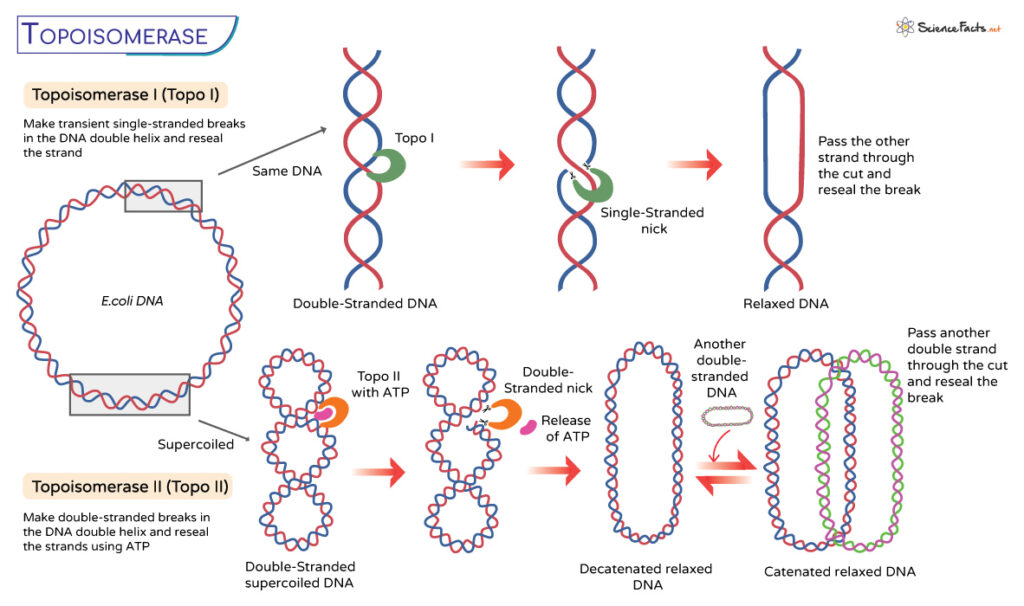The first DNA topoisomerase was discovered by James Wang in 1971. It was initially named omega protein and is now called Escherichia coli topoisomerase I. Structurally, topoisomerases have a catalytic core involved in the cleavage and rejoining DNA strands, a DNA-binding domain, and an optional ATP binding site found in some enzymes.
How Does Topoisomerase Work
Types of Topoisomerases
Functions of Topoisomerase
Topoisomerase vs. Helicase
Topoisomerase Inhibitors
In such situations, topoisomerase acts like a molecular scissor and untangler. It carefully cuts and reseals the DNA strands, relieving the excess tension and preventing DNA from becoming a tangled mess. It also provides the enzymes involved in processes like replication, transcription, chromosome segregation, and recombination to have access to the DNA.
Type I Topoisomerases
These monomeric enzymes make transient single-stranded breaks in the DNA double helix. It functions independently of ATP and changes the linking number by 1. They perform DNA supercoil relaxation, unknotting of single-strands circles, and decatenation. Type I topoisomerases are of 3 types:
Type II Topoisomerases
Type II topoisomerases are homodimeric or heterotetrameric enzymes that introduce double-stranded breaks in the DNA molecule. It is an ATP-dependent enzyme that changes the linking number by 1. The process starts when type II enzymes attach to the double-stranded DNA substrates. It then proceeds through a strand-passage mechanism. While all type II topoisomerases are involved in DNA relaxation, DNA supercoiling, unknotting, and decatenation, an archetypal bacterial topoisomerase, DNA gyrase, introduces negative supercoiling. Type II topoisomerases are of 2 types: Topoisomerases function to unwind the DNA double helix by making transient cuts in the DNA. Thus, they are like surgeons, acting as molecular scissors that reduce tension in DNA and then repair it during replication. These roles of topoisomerases allow cells to carry out some of the critical biological processes.
DNA Replication
For DNA replication to proceed uninterrupted, the double helix must unwind so that the DNA polymerase can synthesize new complementary strands. Type I topoisomerases help relax the supercoiled regions ahead of the replication fork, thus ensuring smooth and accurate replication.
DNA Repair
When DNA sustains damage, such as single-stranded breaks or lesions, topoisomerases can assist in rejoining the broken ends. They also repair DNA damage caused by radiation and chemicals.
Transcription
RNA polymerase needs access to the DNA template to synthesize RNA molecules during transcription. Supercoiled DNA hinders this process. Topoisomerases help by relaxing the DNA, making it accessible for transcription. They relive the torsional stress caused by the movement of RNA polymerase along the template DNA.
Cell Division
During cell division, topoisomerase II plays a vital role in condensation and segregation of chromosomes. They help correctly distribute the parent chromosome to the two daughter cells, preventing errors.
Gene Expression
Topoisomerase indirectly influences gene expression by changing the accessibility of DNA to transcription factors and some other regulatory proteins. Topoisomerase type I Inhibitors
IrinotecanTopotecanCamptothecin
Topoisomerase II Inhibitors
EtoposideDoxorubicinEpirubicin
